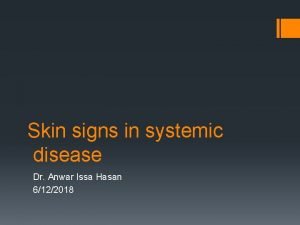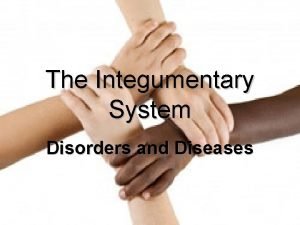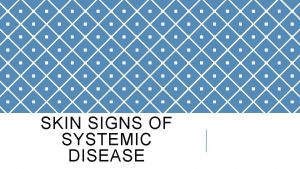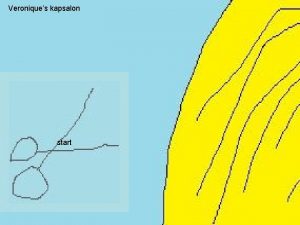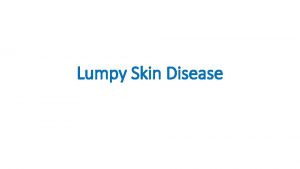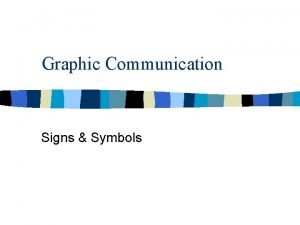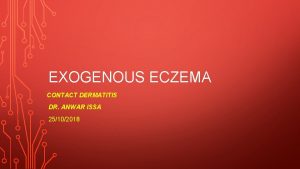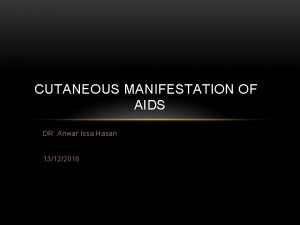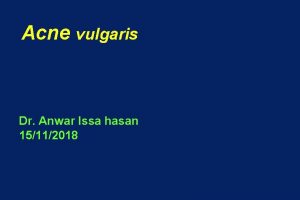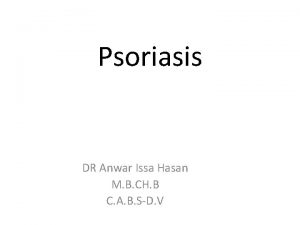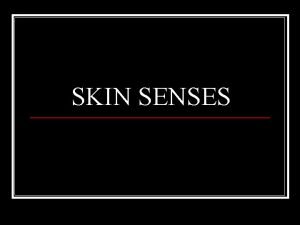Skin signs in systemic disease Dr Anwar Issa















- Slides: 15

Skin signs in systemic disease Dr. Anwar Issa Hasan 6/12/2018

Psychocutaneous disorders § Psychodermatological disorders classify: 1. Psychophysiological : dermatological disorders which are flare with psychological stress, examples psoriasis & atopic dermatitis. 2. Primary psychiatric disorders: § Body dysmorphic disorders. § Psychogenic (neurotic) excoriation § Acne Excoriee. § Trichotillomania. § Dermatitis artefacta. § Delusional parasitosis. 3. Secondary psychiatric disorders : psychological problems secondary to disfiguring skin disease e. g. vitiligo & alopecia areata. 4. Chronic cutaneous sensory disorders: vulvodynia & scrotodynia.

Body dysmorphic disorders § Characterized by distressing or impairing preoccupation with nonexistent or slight defect in appearance. § Psychiatric spectrum from obsessional (numerous visits to physician) to delusional (multiple unnecessary surgeries), age 30 -35 years , present up to 10 -15% of dermatological patients. § Patients usually concerned with nose, mouth , hair, breast or genitalia & seeking for multiple cosmetic procedures. § Rx: selective serotonin reuptake inhibitors (SSRI).

Psychogenic(neurotic) excoriation § A conscious , repetitive , uncontrollable desire to pick, rub, or scratch the skin, psychiatric spectrum most closed to OCD but may be expression of depression or anxiety, § Most middle age , females>male, favors scalp, face, upper back, extensor forearms, shins & buttocks. § Clinical signs: erosion(prurigo simplex), deep circular or linear ulceration with hypertrophic borders, hypo or hyper pigmented scars & healed scars (chronicity). § Rx: oral antihistamine for pruritus , TCAs or SSRI & treatment of dermatological signs e. g. scars &PIH.

Trichotillomania § Alopecia result from patient's repetitive self pulling of hair. § Psychiatric spectrum; habitual hair pulling to impulsive disorders to OCD. § Age : peak 8 -12 years , females > males , most scalp hair, but also eye brows, eyelashes or pubic hair. § Clinical: local nonscaring alopecia with hairs of varying lengths within area of alopecia (broken hair). § Ddx : AA. & Tinea capitis. § Rx: behavioral modification is primary treatment & SSRI.

Dermatitis artefacta § Self inflicted lesions as means to satisfy psychological need that is not consciously understood , self denial. § Most patients are borderline personality , may anxiety or depression. § Age : young , females>males. § Clinical: sites of lesions at easy to reach areas, bizarre shape & configurations. § Rx : symptomatic treatment of wounds& psychotherapy.

Delusional parasitosis § Amonosymptomatic , hypochondrial psychosis , characterized by fixed & false belief that individual is infested with parasites , despite any objective evidence. (this delusion is encapsulated & other mental functions are intact). § Age : 50 s-60 s. § Clinical: experience formication which is cutaneous sensation of crawling, biting & stinging , patients bring bits of skin, lint, & other specimens to prove the existence of parasites ( matchbox sign). § Rx : pimozide ( antipsychotic).

Skin sings in GIT disorders § Skin sings in IBD: 1. Erythema nodosum: reflect active bowel disease. 2. Urticaria. 3. Cutaneous vacuities. 4. Pyoderma gangerosum : common, ulcerative, pustular & peristomal, 5. Oral lesions: aphthosis , angular chelitis, granulomatous infiltration & pyostomatitis vegetans. 6. Perianal fistula , contagious anogenital metastases of chrons disease, 7. Acquired acrodermatitis entropathica: result from zinc deficiency.

Skin signs in liver diseases § Cirrhosis: spider angiomas &telangiectasia, palmar erythema, terry's and muehrckes nail, pruritus & jaundice. § Hepatitis C or B : lichen planus , porphyria cutanae tarda , necrolytic acral erythema, sarcodosis, pruritus , urticaria & vacuities. § Hemochromatosis : generalized hyperpigmentation (bronze DM). § Primary biliary cirrhosis: jaundice , pruritus, diffuse hyperpigmentation & xanthomas ,

Skin signs in endocrine disorders Skin finding in the thyroid disorders Hyperthyroidism Hypothyroidism Cutaneous changes Smooth , warm &moist skin(hyperhidrosis) , pruritus & hyperpigmentation. Dry , coarse, cold &pale , myxedema, yellowish discoloration, easy bruising. Cutaneous diseases Pretibial myxedema, urticaria, dermoghraphism & increase risk vitiligo Acquired ichthyosis, palmoplantor keratoderma, xanthomas &increase risk of vitiligo. Hair changes Fine , thin , diffuse alopecia. Coarse , dull , brittle, alopecia of lateral third of eye brows. Nail changes Onycholysis , koilonychia, clubbing of fingers. Thin , brittle, slow growth.

Skin signs in endocrine disorders Skin changes in Cushing syndrome 1. Change in fat distribution: 2. 3. 4. 5. moon face, buffalo hump, increase in abdominal fat & reduced in limbs fat. Skin atrophy, striae , purpura , reduced wound healing. Cutaneous infection: fungal infection. Acne Hirsutism. Skin changes in Addison disease 1. Diffuse hyperpigmentation, mucosal membrane, nail, hair, flexures, truma sites. 2. Loss of ambisexual hair. 3. Calcification of cartilage e. g. ear.

Skin signs in DM 1. 2. 3. 4. 5. 6. 7. 8. Skin : pale , dry , loss of hair & nail, pruritus, foot ulcer ( diabetic angiopathy), poor sensation ( diabetic neuropathy). Acanthosis nigricans (AN): in insulin resistant DM. Carotenmia : 10% of DM patient. Diabetic bullae : tense non inflammatory bullae in lower extremities. Acral erythema: nonblanching erythema. Diabetic dermopathy : brown atrophic macules & patches at legs. Necrobiosis lipoidica diabeticorm : atrophic brown patch with yellow center , may ulceration or discharge , mostly on legs. Increase skin infection : mostly candidiasis & other fungal infections.

Skin signs in chronic renal failure 1. Pruritus. 2. Dry skin , hyperpigmentation , purpura , 3. Half & half nail : proximal part of nail is white and the distal part is pink. 4. Perforating diseases: perforating folliculitis & kyrles disease. 5. Uremic frost. 6. Pseudoporphyria.

Skin signs in neutertional diseases Vitamins & minerals Skin sings in deficiency of vitamins & minerals Iron Alopecia , koilonychia, glossitis & angular chelitis. zinc Acral & Periorificial dermatitis , poor wound healing & alopecia Vitamin C Scurvy, perifollicular hyperkeratosis, corkscrew hair , bleeding gum. Niacin (B 3) /pellagra Dermatitis on sun exposed sites , hyperpigmentation with erosions Casals necklace sign Biotin (B 7)/ genetic or acquired raw eggs intake &anticonvulsant drugs Alopecia , eczematous dermatitis resembling to acrodermatitis entropathica. Vitamin D Alopecia , acne & eczema.

